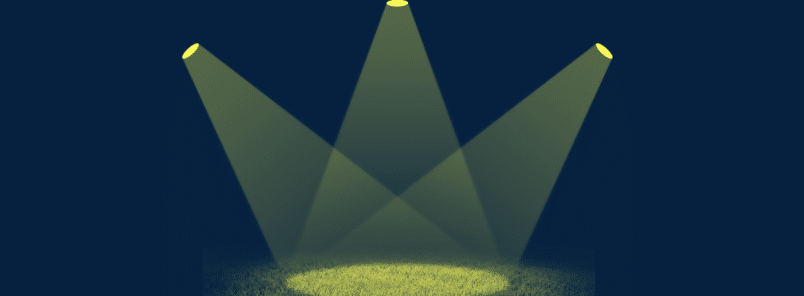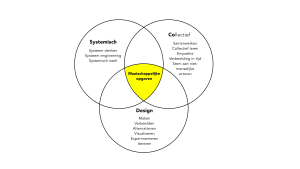Working on complex issues
No one can solve today’s major social challenges alone. Think of climate change, the aging population, cybercrime and privacy issues. These complex issues require a collective effort in which different lenses are applied to these issues.
This requires expertise about change within collectives, about how systems work and about how you can actually bring new ideas into the world and shape them. However, practical experience shows that these areas of expertise are often separate worlds, each with their own theories, models, methods and tools.
Our goal as the Expertnetwork Systemic Co-design (ESC) is to contribute to transition issues in the areas of sustainability, digitalization and health from the lenses of systems thinking AND design AND the collective. We do this through practice-oriented research into ways in which these three lenses can reinforce each other and be further developed together.
A first step is to determine what the three lenses entail and how they can work synergistically in transition issues.
Systemic
The lens of systems thinking includes various movements that address the complexity of systems: systems thinking, systems engineering, complexity theory, but also systemic work (from, for example, change management and psychotherapy). This involves distinguishing the different elements in the system and the relationships and interactions between those elements. It takes place at different layers and scale levels, at different moments in time and it can involve both explicit and implicit (f)actors, depending on what is relevant to the issue at that time.
Collective
‘Co’ in Systemic Co-Design stands for the collective: collaboration and learning together by the various parties involved in the task and the development of possible interventions or actions. In transition tasks, the responsibility for content and process often lies with the various parties involved. The expertise within the collective relates, among other things, to facilitating collaboration and learning processes, working empathetically and understanding each other and giving a voice to those involved, including non-human ones.
Design
Designers who work on complex issues with or between many different stakeholders often work iteratively. Despite of uncertainty, they are trained to take concrete steps and make progress, partly by using visual and generative methods and resources. This makes the issue and possible solutions clearer. Designers, together with those involved, imagine and investigate alternative futures and solutions to experiment with new ways of collaboration, and often take a facilitating role in the process.
Systemic Co-Design
The three lenses below are like stage lights (Figure 1), each illuminating part of what is happening on stage. Each spotlight is needed for the correct lighting and they must be properly adjusted to each other. Sometimes a lamp needs to be dimmed temporarily. For example, it may be necessary to consider systemic questions before anything can be designed or re-imagined, or to pay more attention to the collaboration process for a while.
Figure 1: Systemic Co-Design
An example project illustrates how the systemic view, collaboration in the collective and a design approach can complement each other in practice. In this project, work is being done within neighborhoods to increase biodiversity in cities, giving residents more options for action. The goal is to eventually use this approach in other neighborhoods and cities. By tackling this project through collective collaboration, residents will come up with ways to achieve more biodiversity in their neighborhood. By introducing a design perspective, they consciously experiment with these methods to gradually improve them. The transferability of the methods to other cities and neighborhoods becomes the focus. Designers will also ‘reframe’ the question: they investigate the possibility of completely different ways of working than the residents first thought. By looking at the issue systemically, the entire city is viewed as an ecosystem. This results, for example, in the insight that certain plants in a specific neighborhood are threatened by exhaust fumes and other related ideas such as banning cars. The systemic lens also helps to look at a cooperation between neighborhoods. In short: we can work on issues in an enriched and more effective way by looking at them from the collective, design and systemic perspective, see figure 2.
Figure 2: Working on social challenges based on Systemic Co-Design
Expertnetwork Systemic Co-design
As an expertnetwork, we work in various ways to further define and implement Systemic Co-Design (SCD). We organize learning events, from workshops to networking events and multi-day conferences (such as the RSD in Amsterdam). We conduct practice-oriented research, develop education and work on professionalization. Questions we are working on include: Who is a Systemic Co-Designe and what does this designer do? Does such a person even exist, or is it always an SCD team? One person cannot master all the expertise of systems thinking, collective work and design, so how do you proceed? What is actually being asked of (f)actors in transition issues and what do they need? How do you organize SCD? What is an ‘SCD culture’ and what does it do? What mindset, language or languages are needed to work together? How can we use imagination in time (past – present – future) to literally and figuratively make room for new ways of thinking and doing? How do you deal with chaos, inequality and how can you make blind spots of yourself and others visible? How do you respectfully dismantle existing systems to make room for new ones?
In the coming years, we hope to further develop the concept of Systemic Co-Design by developing theory, models and practical tools that contribute to answering questions from the field and thus contribute to the acceleration of the transition to a healthy, digitally responsible and circular society.


